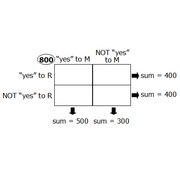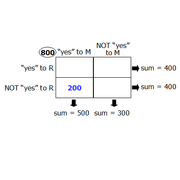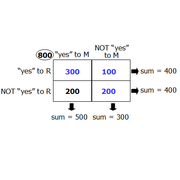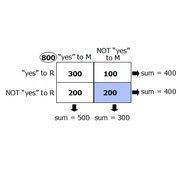Tough one!
This topic has expert replies
-
Amrabdelnaby
- Master | Next Rank: 500 Posts
- Posts: 137
- Joined: Fri Nov 13, 2015 11:01 am
- Thanked: 1 times
- Followed by:2 members
GMAT/MBA Expert
- Brent@GMATPrepNow
- GMAT Instructor
- Posts: 16207
- Joined: Mon Dec 08, 2008 6:26 pm
- Location: Vancouver, BC
- Thanked: 5254 times
- Followed by:1268 members
- GMAT Score:770
One approach is to use the Double Matrix Method. This technique can be used for most questions featuring a population in which each member has two characteristics associated with it (aka overlapping sets questions).----------------YES---------NO----UNSURE
Subject M----500--------200-----100
Subject R----400--------100-----300
A total of 800 students were asked whether they found two subjects, M and R, interesting. Each answer was either "yes" or "no" or "unsure", and the numbers of students who gave these answers are listed in the table above. If 200 students answered "yes" only for subject M, how many of the students did not answer "yes" for either subject?
A. 100
B. 200
C. 300
D. 400
E. 500
Here, we have a population of students, and the two characteristics are:
- Said "yes" to liking subject M or didn't say "yes" to liking subject M
- Said "yes" to liking subject R or didn't say "yes" to liking subject R
IMPORTANT: Notice that I just lumped the "unsure" respondents in with those who answered "no." It's okay to do this since the question is only interested in those who did not answer "yes"
So, we can CONDENSE our table to get:
Subject M: 500 answered "yes," and 300 did NOT answer "yes"
Subject R: 400 answered "yes," and 400 did NOT answer "yes"
We can now set up our diagram as follows:

The question tells us 200 students answered "yes" only for subject M
So, we know that 200 students can be placed in the bottom-left box:

From here, we can find the other values in the empty boxes:

The question asks: How many of the students did not answer "yes" for either subject?
The bottom-right box represents those students:

So, the correct answer is B
------------------------
NOTE: This question type is VERY COMMON on the GMAT, so be sure to master the technique.
To learn more about the Double Matrix Method, watch our free video: https://www.gmatprepnow.com/module/gmat- ... ems?id=919
Once you're familiar with this technique, you can attempt these additional practice questions:
Easy Problem Solving questions
- https://www.beatthegmat.com/the-aam-aadm ... 72242.html
- https://www.beatthegmat.com/finance-majo ... 67425.html
Medium Problem Solving questions
- https://www.beatthegmat.com/probability- ... 73360.html
- https://www.beatthegmat.com/posted-speed ... 72374.html
- https://www.beatthegmat.com/motel-t271938.html
- https://www.beatthegmat.com/of-the-appli ... 70255.html
- https://www.beatthegmat.com/opening-nigh ... 64869.html
- https://www.beatthegmat.com/ds-french-ja ... 22297.html
Difficult Problem Solving questions
- https://www.beatthegmat.com/ratio-problem-t268339.html
- https://www.beatthegmat.com/overlapping- ... 65223.html
- https://www.beatthegmat.com/fractions-t264254.html
- https://www.beatthegmat.com/overlapping- ... 64092.html
- https://www.beatthegmat.com/mba/2011/05/ ... question-2
Easy Data Sufficiency questions
- https://www.beatthegmat.com/for-what-per ... 70596.html
- https://www.beatthegmat.com/ds-quest-t187706.html
Medium Data Sufficiency questions
- https://www.beatthegmat.com/sets-matrix-ds-t271914.html
- https://www.beatthegmat.com/each-of-peop ... 71375.html
- https://www.beatthegmat.com/a-manufacturer-t270331.html
- https://www.beatthegmat.com/in-costume-f ... 69355.html
- https://www.beatthegmat.com/mba/2011/05/ ... question-1
Difficult Data Sufficiency questions
- https://www.beatthegmat.com/double-set-m ... 71423.html
- https://www.beatthegmat.com/sets-t269449.html
- https://www.beatthegmat.com/mba/2011/05/ ... question-3
Cheers,
Brent
-
Amrabdelnaby
- Master | Next Rank: 500 Posts
- Posts: 137
- Joined: Fri Nov 13, 2015 11:01 am
- Thanked: 1 times
- Followed by:2 members
Hi Brent,
I am very well aware of the double matrix method, yet i did not use it in here because i got bugged by the fact that there are 3 scenarios not only 2.
I didn't think of the fact that I could merge no and not sure into one scenario.
Thanks for the enlightenment.
I am very well aware of the double matrix method, yet i did not use it in here because i got bugged by the fact that there are 3 scenarios not only 2.
I didn't think of the fact that I could merge no and not sure into one scenario.
Thanks for the enlightenment.
Brent@GMATPrepNow wrote:One approach is to use the Double Matrix Method. This technique can be used for most questions featuring a population in which each member has two characteristics associated with it (aka overlapping sets questions).----------------YES---------NO----UNSURE
Subject M----500--------200-----100
Subject R----400--------100-----300
A total of 800 students were asked whether they found two subjects, M and R, interesting. Each answer was either "yes" or "no" or "unsure", and the numbers of students who gave these answers are listed in the table above. If 200 students answered "yes" only for subject M, how many of the students did not answer "yes" for either subject?
A. 100
B. 200
C. 300
D. 400
E. 500
Here, we have a population of students, and the two characteristics are:
- Said "yes" to liking subject M or didn't say "yes" to liking subject M
- Said "yes" to liking subject R or didn't say "yes" to liking subject R
IMPORTANT: Notice that I just lumped the "unsure" respondents in with those who answered "no." It's okay to do this since the question is only interested in those who did not answer "yes"
So, we can CONDENSE our table to get:
Subject M: 500 answered "yes," and 300 did NOT answer "yes"
Subject R: 400 answered "yes," and 400 did NOT answer "yes"
We can now set up our diagram as follows:
The question tells us 200 students answered "yes" only for subject M
So, we know that 200 students can be placed in the bottom-left box:
From here, we can find the other values in the empty boxes:
The question asks: How many of the students did not answer "yes" for either subject?
The bottom-right box represents those students:
So, the correct answer is B
------------------------
NOTE: This question type is VERY COMMON on the GMAT, so be sure to master the technique.
To learn more about the Double Matrix Method, watch our free video: https://www.gmatprepnow.com/module/gmat- ... ems?id=919
Once you're familiar with this technique, you can attempt these additional practice questions:
Easy Problem Solving questions
- https://www.beatthegmat.com/the-aam-aadm ... 72242.html
- https://www.beatthegmat.com/finance-majo ... 67425.html
Medium Problem Solving questions
- https://www.beatthegmat.com/probability- ... 73360.html
- https://www.beatthegmat.com/posted-speed ... 72374.html
- https://www.beatthegmat.com/motel-t271938.html
- https://www.beatthegmat.com/of-the-appli ... 70255.html
- https://www.beatthegmat.com/opening-nigh ... 64869.html
- https://www.beatthegmat.com/ds-french-ja ... 22297.html
Difficult Problem Solving questions
- https://www.beatthegmat.com/ratio-problem-t268339.html
- https://www.beatthegmat.com/overlapping- ... 65223.html
- https://www.beatthegmat.com/fractions-t264254.html
- https://www.beatthegmat.com/overlapping- ... 64092.html
- https://www.beatthegmat.com/mba/2011/05/ ... question-2
Easy Data Sufficiency questions
- https://www.beatthegmat.com/for-what-per ... 70596.html
- https://www.beatthegmat.com/ds-quest-t187706.html
Medium Data Sufficiency questions
- https://www.beatthegmat.com/sets-matrix-ds-t271914.html
- https://www.beatthegmat.com/each-of-peop ... 71375.html
- https://www.beatthegmat.com/a-manufacturer-t270331.html
- https://www.beatthegmat.com/in-costume-f ... 69355.html
- https://www.beatthegmat.com/mba/2011/05/ ... question-1
Difficult Data Sufficiency questions
- https://www.beatthegmat.com/double-set-m ... 71423.html
- https://www.beatthegmat.com/sets-t269449.html
- https://www.beatthegmat.com/mba/2011/05/ ... question-3
Cheers,
Brent
- GMATGuruNY
- GMAT Instructor
- Posts: 15539
- Joined: Tue May 25, 2010 12:04 pm
- Location: New York, NY
- Thanked: 13060 times
- Followed by:1906 members
- GMAT Score:790
Alternate approach:----------------YES---------NO----UNSURE
Subject M----500--------200-----100
Subject R----400--------100-----300
A total of 800 students were asked whether they found two subjects, M and R, interesting. Each answer was either "yes" or "no" or "unsure", and the numbers of students who gave these answers are listed in the table above. If 200 students answered "yes" only for subject M, how many of the students did not answer "yes" for either subject?
A. 100
B. 200
C. 300
D. 400
E. 500
Use a Venn diagram to represent all of the YES voters:

The TOTAL who voted YES for M = 500.
The number who voted YES for ONLY M = 200.
Thus, the number who voted YES for BOTH M AND R = 300.
Since the TOTAL number who voted YES for R=400, and 300 of these people voted YES for BOTH M AND R, the number who voted YES for ONLY R = 400-300 = 100.
Adding the values in the Venn diagram, we get:
Total number of YES voters = 200+300+100 = 600.
Since the total number of voters = 800, and the total number of YES voters = 600, the number who did NOT vote YES = 800-600 = 200.
The correct answer is B.
Private tutor exclusively for the GMAT and GRE, with over 20 years of experience.
Followed here and elsewhere by over 1900 test-takers.
I have worked with students based in the US, Australia, Taiwan, China, Tajikistan, Kuwait, Saudi Arabia -- a long list of countries.
My students have been admitted to HBS, CBS, Tuck, Yale, Stern, Fuqua -- a long list of top programs.
As a tutor, I don't simply teach you how I would approach problems.
I unlock the best way for YOU to solve problems.
For more information, please email me (Mitch Hunt) at [email protected].
Student Review #1
Student Review #2
Student Review #3
Followed here and elsewhere by over 1900 test-takers.
I have worked with students based in the US, Australia, Taiwan, China, Tajikistan, Kuwait, Saudi Arabia -- a long list of countries.
My students have been admitted to HBS, CBS, Tuck, Yale, Stern, Fuqua -- a long list of top programs.
As a tutor, I don't simply teach you how I would approach problems.
I unlock the best way for YOU to solve problems.
For more information, please email me (Mitch Hunt) at [email protected].
Student Review #1
Student Review #2
Student Review #3
-
Amrabdelnaby
- Master | Next Rank: 500 Posts
- Posts: 137
- Joined: Fri Nov 13, 2015 11:01 am
- Thanked: 1 times
- Followed by:2 members
Hi Guru and Brent,
I think I can solve it as well without neither venn nor double matrix.
I remember that Guru solved a similar one before using a simple equation:
total yes = yes M + yes R - yes both
total yes = 500 + 400 - 300 = 600
hence not yes is equal to 200
i got yes both by subtracting yes m from the 200 who exclusively voted for m
I think I can solve it as well without neither venn nor double matrix.
I remember that Guru solved a similar one before using a simple equation:
total yes = yes M + yes R - yes both
total yes = 500 + 400 - 300 = 600
hence not yes is equal to 200
i got yes both by subtracting yes m from the 200 who exclusively voted for m
GMATGuruNY wrote:Alternate approach:----------------YES---------NO----UNSURE
Subject M----500--------200-----100
Subject R----400--------100-----300
A total of 800 students were asked whether they found two subjects, M and R, interesting. Each answer was either "yes" or "no" or "unsure", and the numbers of students who gave these answers are listed in the table above. If 200 students answered "yes" only for subject M, how many of the students did not answer "yes" for either subject?
A. 100
B. 200
C. 300
D. 400
E. 500
Use a Venn diagram to represent all of the YES voters:
The TOTAL who voted YES for M = 500.
The number who voted YES for ONLY M = 200.
Thus, the number who voted YES for BOTH M AND R = 300.
Since the TOTAL number who voted YES for R=400, and 300 of these people voted YES for BOTH M AND R, the number who voted YES for ONLY R = 400-300 = 100.
Adding the values in the Venn diagram, we get:
Total number of YES voters = 200+300+100 = 600.
Since the total number of voters = 800, and the total number of YES voters = 600, the number who did NOT vote YES = 800-600 = 200.
The correct answer is B.
-
chetan.sharma
- Senior | Next Rank: 100 Posts
- Posts: 46
- Joined: Sun Dec 27, 2015 7:03 am
- Thanked: 8 times
- Followed by:1 members
Hi,Amrabdelnaby wrote:Pls help
We need not get into other info provided.
We know total as 800..
M : Yes=500, but it is given that 200 have said 'Yes' for only M..
this means 500-200=300 have said for both..
so total who have said yes= 500+400-300=600..
those who have not said 'yes'= 800-600=200
B




















